

Hello to everyone at Bilingual Books! Most recently, I’ve been enjoying a lot of Hebrew lately especially in the last few weeks, and even managed to memorize the first stanza of the HaTikvah, the beautiful Israeli national anthem, in Hebrew! Today, I would like to explain to you some of my personal tips on how I enjoy learning a language while having fun doing it!
When I begin to learn a new word or continue to trek along through a 10 minutes a day book, I find it helpful to write down the word in the given language, several times, while saying the new word to myself. I may wish to include it in a sentence in the context of a recent verb I’ve learned adding it to my vocabulary.
Personally, with Hebrew, I really enjoy logging in to Google Earth and enjoy some photography or panoramas from Israel to whisk me into the feel of being in a situation speaking my new language. I find it really fun to do this, whether I find myself at the Western Wall or narrow streets of Jerusalem, a serene setting in the beautiful Hula Valley or near the  Sea of Galilee, in the dry Negev desert, or overlooking the bustling city of Tel Aviv from the stone streets of Jaffa. Another helpful thing I enjoy doing is to not only practice my words while I am writing down the words with my 10 minutes a day book, but rather to enjoy the new sounds of the language in the context of sentences while I’m going around my home, drilling the words into my head.
Sea of Galilee, in the dry Negev desert, or overlooking the bustling city of Tel Aviv from the stone streets of Jaffa. Another helpful thing I enjoy doing is to not only practice my words while I am writing down the words with my 10 minutes a day book, but rather to enjoy the new sounds of the language in the context of sentences while I’m going around my home, drilling the words into my head.
When I enjoy the winning combination of speaking and writing Hebrew while in Israel on Google Earth, I find it also fun to additionally have the HEBREW a language map on display, or even to enjoy a Coca-Cola! Another thing I love about the Bilingual Books set is at the end of a page in a 10 minutes a day book, there are additional vocabulary words in a yellow band. These are great for extra, on-the-go vocabulary words, many of them being very easy to acquire. Finally, I would like to point out how much I appreciate your hard work on the CD-Rom as it provides great words in the book. Without the CD-Rom, I probably would not have the Hebrew accent, and would have pronounced all of my words wrong. As I have stated before, I love Bilingual Books’ products, and enjoy as they provide useful words and phrases that will lead any traveller to an immediate speaking ability in any language. Here I have given you some of the basic tips that I use for enjoying learning my new language.
Finally, I would like to ask Mrs. Kershul two quick questions concerning HEBREW in 10 minutes a day. First, I was curious on how the Hebrew language acquired so much demand. Is it based on the amount of 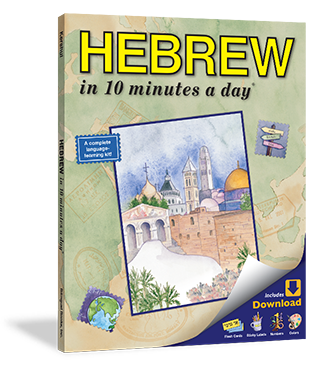 tourism in Israel, or for the Jewish people residing in America?
tourism in Israel, or for the Jewish people residing in America?
My second question is a question that has been on my mind for quite some time. I am curious how in Hebrew numbers can so easily change. For instance, the word “two” changes many times in Hebrew, especially on page 53 of the book, changing several times.
Thank you again for our time and for reading this entry. Have a fantastic new week!
Sincerely,
Fraser
Hello Fraser,
Hebrew went from being almost a dead language about a century ago to now being a language spoken by over 5 million in Israel as well as another 5 to 10 million outside of Israel if you include native and non-native speakers around the world. The Hebrew language is an integral part of Jewish life and ceremonies. The study of Hebrew for one's Bar or Bat Mitzvah, the Jewish coming of age ritual, is one such example of the central role which the language plays in the religious and ethnic lives of Jews around the world.
According to Israeli statistics about 2.8 million tourists visited Israel in 2011. It is estimated that 60% of these came from Europe and 28% from North America. Keep in mind that people of many religions visit Israel because of its central importance to not just Judaism, but also Islam and Christianity.
I will answer your second question shortly. Thank you as always for your wonderful entries on the Language Club forum.
Kristine Kershul
Hello Again Fraser,
You asked about how the numbers change in Hebrew. There are two sets of numbers in Hebrew, masculine and feminine. When used with a noun they have to agree with the gender of that noun. In English we don't have this grammar point. The number "two" is a special case. When it is placed before a noun, for example when you say "two boys" or "two girls" it has an entirely different form which you have seen used in our Hebrew book. In addition to the two sets of cardinal numbers, one, two, three, etc., there are also two sets of ordinal numbers, first, second, third, etc. This is why you see the Hebrew numbers in different forms. I hope this helps.
Kristine Kershul
Hello everyone at Bilingual Books! For today, I would like to speak briefly about my Christmas, and also about an interesting language family scattered throughout Europe and Asia, The Ural-Altaic language family!
To start, I hope that you each had a merry Christmas and sincerely wish everyone a happy new year. As the Christmas school break set in, I began to hope for Bilingual Books products, of course! I had asked my parents for a language map in my stocking. I had ITALIAN a language map particularly in mind as recently, Bilingual Books had a 50% off deal for anything Italian; but when I opened it, I found Bilingual Book’s ITALIAN, GERMAN, and RUSSIAN language maps! I have thoroughly been enjoying all of these great phrase guides since then.
Under the Christmas tree, I received PORTUGUESE in 10 minutes a day as a gift. Though I still am focusing on learning the Hebrew language, I plan on delving into learning the Bilingual Books product for learning Portuguese soon, as I love the culture, geography, and of course, language, of Brazil and Portugal alike. Another great reason to learn Portuguese for me is that my cousin-in-law grew up in Brazil speaking the Portuguese language. As you may notice, because Portuguese is derived from Latin like Spanish, the two languages have many similarities. So a special thanks to Bilingual Books again on your spectacular work on these products.
language, of Brazil and Portugal alike. Another great reason to learn Portuguese for me is that my cousin-in-law grew up in Brazil speaking the Portuguese language. As you may notice, because Portuguese is derived from Latin like Spanish, the two languages have many similarities. So a special thanks to Bilingual Books again on your spectacular work on these products.
For today, I thought it might also be interesting to give a brief section on two Ural-Altaic languages, Turkish and Mongolian.
The interesting thing about Mongolian is that it is spoken in a region mainly given to the Sino-Tibetan language family, such as Chinese, but Mongolian itself is part of the Ural-Altaic language family. As for Turkish, it is unusual as it is an Altaic language spoken in the Middle East; this whole interesting language family is spoken in scattered parts throughout Europe and Asia including Finland, Estonia, Hungary, Turkey, Mongolia, and Russia.
Mongolian is spoken natively in both Mongolia and Inner Mongolia, a region of China, with an approximate population of 5.7 million. In Mongolia, the Cyrillic script is used for writing the language. In China, the traditional Mongolian script is used. The Mongolian script is also known as the Uyghurjin Mongol Bichig. It is mainly derived from Uighur.
Turkish as a population of over 63 million speakers and has an approximate value of 40% of the Turkic speakers. It is written using the Turkish alphabet based off the Latin alphabet. In one of Atatürk’s reforms, the Ottoman script was replaced with the Latin alphabet. Turkish is officially spoken in Turkey, Cyprus, and Northern Cyprus. It is also a minority in Kosovo, Macedonia, and Romania.
Thanks again for visiting the Language Club. I hope you’ve learned much more about the Ural-Altaic languages. Join me next time for another blog entry,
Sincerely,
Fraser
Hello to everyone at Bilingual Books!
Today I would like to speak about something concerning languages that I haven’t spoken about yet…the ancient languages of Persia, Babylon, Canaan, and Ancient Egypt. This is more of an entry centered on facts and history, as these languages are an awesome aspect of language that we usually don’t think about. Let’s go!
To start, I would like to cover Old Persian, Hebrew, Aramaic, and Ancient Egyptian. The Old Persian language is native to Ancient Iran, and descends from the Indo-Iranian branch of the Indo-European languages. It was written in Old Persian cuneiform, written from the left to the right, as we do in the English language. Inscriptions from the Old Persian language can be found in inscriptions, tablets, and seals from the time period lasting from 600-300 BC in Ancient Persia. When you next admire the ruins of Persepolis or Susa, just remember the amazing language of the Persians!
Ancient Hebrew is an awesome language as it was spoken in the ancient kingdoms of Israel and Judah. Regarded mainly as the language of the Israelites, and their ancestors, the Jewish people, the Hebrew language ceased to be a spoken language in approximately 200 AD; but by the 19th century AD, the Jewish people began to revive their beautiful language, and today, according to Ethnologue, has 5.3 million speakers, mainly centered around the nation of Israel in the near east today. Hebrew is a Canaanitic language and belongs to the North West Semitic branch. It flourished as a spoken language in the kingdoms of Israel and Judah between 900 and 600 BC.
Following the exile in Babylon, the Jewish people began using Aramaic as a predominant language. This leads us to another of our Ancient language topics, Aramaic! This, in fact, was the day-to-day language in the 2nd Temple period in Palestine, which lasted from 539 BC to 70 AD. In fact, large sections of the books of Daniel and Ezra are written in Aramaic.
Many people are fascinated by the ancient pyramids in Giza, the immense sphinx, and some smatterings of Egyptian history; but which language was predominantly spoken in these ancient time periods? Egyptian, the language commonly written in hieroglyphics, is an Afro-Asiatic language, used by these fascinating people. Before 2600 BC, the Egyptians spoke the Archaic Egyptian language, but as time wore on, the Old Egyptian language, which was used between 2686-2181 BC. The Pyramid Texts, a group of Ancient Egyptian religious texts, are the example of Egyptian literature using the Old Egyptian form of the language. From the period mentioned, tomb walls of the elite Egyptians had autobiographical writings representing this stage of the Egyptian language. Today, the language of the Egyptians has been preserved by the Coptic Church in Egypt.
hieroglyphics, is an Afro-Asiatic language, used by these fascinating people. Before 2600 BC, the Egyptians spoke the Archaic Egyptian language, but as time wore on, the Old Egyptian language, which was used between 2686-2181 BC. The Pyramid Texts, a group of Ancient Egyptian religious texts, are the example of Egyptian literature using the Old Egyptian form of the language. From the period mentioned, tomb walls of the elite Egyptians had autobiographical writings representing this stage of the Egyptian language. Today, the language of the Egyptians has been preserved by the Coptic Church in Egypt.
Finally, I would like to close by thanking you for reading this entry on the wonders of Ancient languages. I also would like to ask a question for Mrs. Kershul: do you think that you will ever create a language product for an ancient language?
Thanks again for your time. See you next time at the language club! To everyone at Bilingual Books; I would like to wish you a very Merry Christmas and a great New Year. I’ve had a lot of fun with your products this past year. See you next year!
Sincerely,
Fraser
Hi Fraser!
What an amazing amount of information you have shared about these ancient languages! Thank you very much.
Our products are designed to give people a basic conversational ability in a foreign language and are not structured in a way that would be logical for the study of ancient languages. We don’t have any plans for the ancient languages, but I am pleased to point out that we have products for Modern Hebrew, Modern Arabic and Modern Farsi. Those languages are three modern versions of the four ancient languages you discussed. There is a modern version of Aramaic, but it is spoken by very few and has been mixed together with Arabic and Hebrew in some communities.
Fraser, your language studies always impress us and we thank you for all that you share.
Happy Holidays to you and your family!
Kristine Kershul
Hello everyone at Bilingual Books! I would like to speak today about the fascinating Tibetan languages of Tibet, Bhutan, Nepal, and India as they are an extremely interesting group of languages.
The Tibetan languages reside linguistically in the incredibly large Sino-Tibetan language family. It includes several well-known languages such as Lhasa Tibetan, Dzongkha, Sikkimese, and Sherpa. As I recently have been very fascinated by the incredible Sherpa people and language, a Tibetan people from the beautiful valleys and snow-capped mountains of Nepal, I thought it would be interesting to conduct a brief survey of these Tibetic languages collectively, covering Dzongkha, Lhasa Tibetan, Sherpa, and the Tibetic languages in general. Let’s get started!
High in the mountains and valleys of Bhutan, the Dzongkha speaking people reside. As a South Tibetan language, Dzongkha has been derived from the Old Tibetan language through many years of separation. It is partially intelligible and related to the Sikkimese language of India. Dzongkha is written using the Bhutanese form of the Tibetan script. Did you know that the name “Dzongkha” literally means the language (or kha) spoken in the dzong, which are the fortress resembling monasteries that have been built throughout Bhutan.
Let’s move on to Lhasa, or Standard, Tibetan. This language has a total of 1.3 million speakers with about 5 million speakers of broader Tibetan. This particular language is the most widely spoken form of the Tibetic languages. As Standard Tibetan is based of the Tibetan spoken in Lhasa, it is often called Lhasa Tibetan and uses the beautiful Tibetan script as its writing system.
Tibetic languages. As Standard Tibetan is based of the Tibetan spoken in Lhasa, it is often called Lhasa Tibetan and uses the beautiful Tibetan script as its writing system.
Down in the Solukhumbu district of Nepal live the Sherpa people. From what I know, Sherpa literally means “easterner”, or “east people”. They are generally classified as a Tibetan people, though their language is considered different from Tibetan. The Sherpa live in Nepal, Tibet, Bhutan, and India. There are also some Sherpa in the United States.
In general, the Tibetic languages are spoken by the Tibetan peoples of Asia. The dialects of U-Tsang, or Central Tibet, are generally classified as a single Tibetan language, but other Tibetan languages such as Dzongkha, Sikkimese, Sherpa, and Ladakhi are classified as separate languages. Thanks for reading this entry on the beautiful Tibetan languages of Tibet, Bhutan, Nepal, and India, I really enjoyed researching and writing! Have a fantastic week. See you next time at the Language Club!
All the best,
Fraser
Hello to Fraser - you seem to be the sole blogger for this site! Your enthusiasm is delightful and you appear to have a remarkable intelligence for languages. I am not so remarkable but I have benefitted from the Kershul books and CD's and recommend them always. I use some of it when teaching my kindergarten Spanish and French. They love the sounds and the DVD.
When I go on long trips (twice a year) in the US, I like to take my 10 minutes tapes and listen to them as I drive. The bits and pieces of language are so helpful when I head overseas. I want to thank everyone who works hard at providing small ways to reach out to others - language even just to say thank you and please - is a great advantage!
Mary Kay
Hi everyone at Bilingual Books! Let’s kick off this upcoming week with another cool language map proposal! Get ready because I’m going to be noting why I personally feel WELSH a language map would be a great product for Bilingual Books. I sourced my information from an awesome book I recently acquired named Ethnologue Languages of the World. Let’s start!
To begin, the Welsh language is the cultural dialect of the Welsh people. In the beautiful nation of Wales, this awesome Celtic language is spoken along with English. So why did I pick up on this particular language? There are 5 great reasons, the first being the main one.
- There are 525 Welsh primary and secondary schools that have a Welsh-medium education. In fact this is a decision increasing among parents.
- 19% of those in Wales speak Welsh, while 33% understand it.
- 88% of those once questioned said that “they should be proud of Welsh”.
- Rosetta Stone has discontinued Welsh which is a door open for Bilingual Books.
- There were about 4.5 million tourists to the United Kingdom from the Americas in 1998, (sourced from Canadian Oxford School Atlas, eighth edition), and finally, as an official language of Wales, it has 537,870 speakers worldwide.
Thank you so much for answering my question on the idea for SHERPA a language map, Mrs. Kershul. I was really fascinated when I read that you were considering DZONGHKA a language map for Bilingual Books. I thought that that idea was REALLY cool; as you know, I’m always ready to explore a new language or culture! I also thought it was fascinating that you’ve been to Nepal.
DZONGHKA a language map for Bilingual Books. I thought that that idea was REALLY cool; as you know, I’m always ready to explore a new language or culture! I also thought it was fascinating that you’ve been to Nepal.
Do you still have plans for creating DZONGHKA a language map, and what was the demand for it? I’m really interested! Thank you again your time. Don’t forget to read the final entry for the language map ideas series . . . on languages of Africa: Afrikaans, Xhosa, Zulu, and Shona.
Have a great week!
Sincerely,
Fraser
Hi Fraser, or in Welsh, Helo Fraser,
You do find the most interesting and esoteric languages. These languages might not be commercially viable, but they represent wonderful places to visit.
Given the small number of people in Wales who speak Welsh and the large number of people who speak English, Welsh isn’t a language which would go to the top of our publishing list. I can say from my visits to Wales over the years that the street signs and city names have always amazed me. When spoken they never sound anything like what is written!
Dzonghka also won’t be appearing as one of our titles although the tourism numbers to Bhutan have grown significantly in the last decade.
Xhosa, Zulu and Shona - these are languages I would love to see as part of Bilingual’s publishing program. However, like Welsh, a high percentage of the speakers of these languages also speak English so it is unlikely that Bilingual Books would create a product for these languages.
I have spent a lot of time in sub-Saharan Africa and have tried to master the clicking sound that you hear with Xhosa. No such luck – yet, but I plan to continue practicing and might just get it right one of these days.
Kristine Kershul
Hello, this is Fraser, and for this week, I would like to do something a little different from usual! I am planning on suggesting to Bilingual Books some of my personal ideas about making an additional language map! I have come up with ten interesting ideas, each with reasons why I think they could be a hit. I hope you enjoy reading this as a kickoff for this week.
Last week, I did a report about the Sherpa people of Nepal! I had a lot of fun doing it, and one of the aspects to it was the language of the Sherpa people! In fact, the beautiful Sherpa language is a component of the gigantic Sino-Tibetan 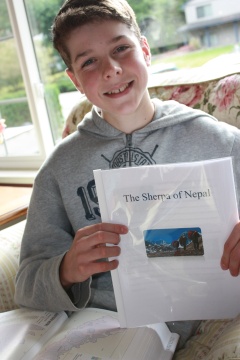 language family of which Chinese is an element. It has a total of 86,200 speakers worldwide. Though the Sherpa people are originally a Tibetan people, today they live in the area around the incredibly large Mt. Everest! As I created this report, I considered Bilingual Books and how cool it would be if they could construct SHERPA a language map. Below, I have listed the pros of composing a language map from this great language!
language family of which Chinese is an element. It has a total of 86,200 speakers worldwide. Though the Sherpa people are originally a Tibetan people, today they live in the area around the incredibly large Mt. Everest! As I created this report, I considered Bilingual Books and how cool it would be if they could construct SHERPA a language map. Below, I have listed the pros of composing a language map from this great language!
First of all, there are many tourists and mountain climbers who brave the harsh conditions on Everest and Sagarmatha National Park in Nepal each year. This is where the Sherpa mainly reside, while many of those who guide these trekkers are Sherpa! On top of that, there are speakers of Sherpa in the United States. I think it is a great language for enthusiasts as it sounds really cool and uses a different script than our own. Did you know that it was the language of Tenzing Norgay, the first to scale the incredible Mt. Everest with Edmund Hillary? Though it is a decreasing language, the Sherpa are extremely proud of their language, and would appreciate anyone who would go to extra measures to communicate to them through their mother tongue.
Before I finish my entry, I have a question for Mrs. Kershul:
Do you think the Sherpa language has a sufficient enough demand that a language map could be made for it? I am interested in your input on whether this idea is logical or not. Thanks!
See you next time at the Language Club.
Sincerely,
Fraser
Hi Fraser,
I have to admit that I don’t know much about the Sherpa language despite time in Nepal many years ago. About nine years ago I investigated doing a Language Map® for Dzongkha which is spoken in Bhutan, but I hadn’t looked at the viability of a Sherpa language product.
I am sure you are correct when you say the Sherpa would appreciate it if foreigners could use a few words in their language. Unfortunately, there is just not enough demand for SHERPA a language map® to make it a part of our publishing program. Possibly that will change with time as just yesterday the “New York Times” Travel Section had a wonderful feature on the kingdom of Mustang which is in Nepal.
As always, thank you for your questions.
Kristine Kershul
Hello everybody! This is Fraser, and today, I would like to speak about another fantastic product from Bilingual Books…GREEK a language map! Personally, I think that the Eastern Mediterranean is a fascinating region on earth. It includes the beautiful Greek islands, the Old City  of Jerusalem, bizarre Cairo and the pyramids at Giza. This region is incredibly beautiful, historical and exotic!!
of Jerusalem, bizarre Cairo and the pyramids at Giza. This region is incredibly beautiful, historical and exotic!!
As you know, we’ve already gone over Hebrew, the Semitic language of Israel, and Arabic, another Semitic tongue, and the most prominent language of North Africa and the Middle East, but we haven’t yet spoken about Greek, an absolutely different language in the Indo-European language family! So let’s get started right now!
First, Greek is an ancient language, once spoken by the Greeks, an ancient civilization; did you know that the New Testament was written in the Greek language? This fascinating country is home to both beautiful and historical landmarks, including Athens and the Greek islands. If you aren’t planning on travelling to Greece, get a language map anyway!! You will enjoy the beautiful alphabet and sounds of this language that resemble the country it’s spoken in.
As you may know, the Greek alphabet is different from our own; but Bilingual Books has provided at the back of your language map an alphabet guide. It contains both upper and lowercase letters, which is a great help for any historical traveller to Greece! In fact the word “alphabet” comes from the first two letters of the Greek alphabet, alpha and beta!
So next time you eat souvlakia and Greek salad, watch the Olympic Games, or say “pentagon”, just remember which country and language it all came from!
Down below I’ve provided you with some phrases to learn over the weekend! Enjoy!
ΓΕΙΑ ΣΟΥ (Hello)
ΠΩΣ ΕΙΣΤΕ; (How are you?)
ΠΩΣ ΣΑΣ ΛΕΝΕ; (What is your name?)
Thanks for visiting the blog today! Have a great weekend!
Sincerely,
Fraser
Hello! This is Fraser, the weekly blog-writer for Bilingual Books! So let’s start off the week with some language stuff!
For today, I’d like to talk about SWAHILI a language map, and HAWAIIAN a language map, two really cool products that I’ve enjoyed from Bilingual Books. To start, I’d like to give a brief history of these two exotic languages, so get ready!
From what I’ve read, the Swahili language is a language influenced by the two cultures that prevailed in East Africa . . . the Arabs and the native Bantu people of Africa. If you have ARABIC and SWAHILI a language map, you might notice that the words for zero, six, seven, and nine, all sound surprisingly similar. This makes sense, seeing the Arab people had a part to play in the Swahili language!
Swahili is mostly famous for being spoken in the intriguing nations of Kenya and Tanzania, but you might be surprised at how many other countries in Central Africa speak it also, so it’s a great language to learn. Besides that, 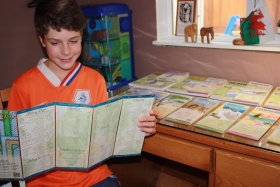 it sounds really cool, and is spoken in one of the coolest places on earth!! You might notice on the back of the language map there are a whole bunch of words for the animals that live on the savannah plains where the language is spoken. The section is called “On Safari”, and I think that was really thoughtful.
it sounds really cool, and is spoken in one of the coolest places on earth!! You might notice on the back of the language map there are a whole bunch of words for the animals that live on the savannah plains where the language is spoken. The section is called “On Safari”, and I think that was really thoughtful.
As for Hawaiian, the native language of the beautiful Hawaiian Islands, it’s the native language of the Aloha State! With HAWAIIAN a language map, you can speak the native language of the Hawaiian Islands that is now being re-born; so when travelling to Hawaii, don’t fail to bring along this great language map!
With it, you will be able to know what Honolulu means in the Hawaiian language! Have you ever heard of the king of Hawaii, Kamehameha? Find out what his name really means along with Waipi’o and the colossal word for the triggerfish, humuhumunukunukuapua’a!!
Thank you for joining me on this adventure through the exotic Bilingual Books languages.
See you next time at the Language Club!
Fraser
Hello every language learner at Bilingual Books! This is Fraser, and today, I would like to talk about the latest additions to my Bilingual Books collection…PASHTO a language map and DARI a language map!! They are two EXCELLENT products from Bilingual Books, and since I’ve got these great language maps, I’ve been thoroughly enjoying them!
From what I’ve learned from the World Book Encyclopedia, Pashto is a language spoken by the Pathan people of fascinating Afghanistan and Pakistan. It is an AWESOME language and one of two of the official languages of Afghanistan. Another language spoken in the Afghanistan is the Dari language, which is spoken by the Tajiks of that country. Now, I have my very own language maps for these two intriguing languages, and I have been enjoying them thoroughly. I would like to congratulate Bilingual Books for their FANTASTIC work on these products; plus, I really like the creative illustration on the front of PASHTO a language map. Like every product I have experienced from Bilingual Books, I 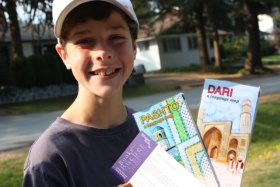 recommend PASHTO and DARI a language map to anyone, especially if you are going overseas with the U.S. military or looking for a cool language to enjoy.
recommend PASHTO and DARI a language map to anyone, especially if you are going overseas with the U.S. military or looking for a cool language to enjoy.
Did you know that Pashto and Dari use different ways of writing numbers? For instance, the number zero is not the familiar figure of 0, but is simply symbolized by a dot. As for the number one, it is a curved line, similar to our symbol for one but slightly curved. As for the figure for six, it could almost be compared to our symbol for seven!! I find it really neat that these well-made language maps are used by the U.S. military for their army deployed overseas!
I do have several questions about my two new language maps for Mrs. Kris Kershul…
Is the illustration on the front panel of PASHTO a language map supposed to be the mosque in Mazar-e Sharif, and have you ever been to Afghanistan? Plus, is Dari somehow related to the Tajik language, seeing it is spoken by the Tajik people from Tajikistan?
Thank you for your time, and all the best in your language learning!
Sincerely,
Fraser
Hi Fraser,
Thank you again for the questions. Yes, the cover illustration for PASHTO a language map® is based upon the mosque in Mazar-e-Sharif. Isn’t the tile work gorgeous?
Both Dari and Tajik derive from Persian and share common elements, but due to geography and history have evolved into separate languages. Sometimes Dari is called “Afghan Persian” and sometimes Tajik is called “Tajik Persian.” Tajik is the official language of Tajikistan whereas Dari is an official language of Afghanistan.
One of the most interesting aspects of the Tajik language is that it used to be written using the Latin and Persian alphabets. Currently the Tajik language is written using the Cyrillic alphabet.
Kristine Kershul
Hello everybody at Bilingual Books!
Today, I would like to speak about another of Bilingual Books’ fantastic products, the 10 minutes a day series! This cool series provides all you need to know for a vacation or trip to numerous spots on the map! The combination of a practical method for learning the language, excellent pronunciation guides, and some great free words for extra everyday vocabulary make learning quick and practical. Then slap on some additional games, quizzes, a glossary, some sticky labels, and beautiful illustrations. In a word, the 10 minutes a day series is AWESOME!!
What I enjoy with this excellent series is that I learn concepts very quickly. With Bilingual Books, it doesn’t take ages to start forming questions and sentences, but before you know it, you can ask questions. This is very encouraging while learning a language,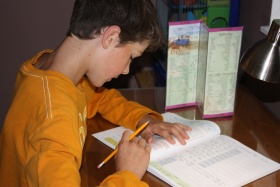 and makes it much more enjoyable. Along with this, at the end of many pages there is a yellow band with a few extra words to learn on-the-go to add to everyday vocabulary! Not enough? There are some cool sticky labels that you can attach to different objects in your home or office to help remember extra vocabulary! Though I’ve only used a few of them, they’re really cool.
and makes it much more enjoyable. Along with this, at the end of many pages there is a yellow band with a few extra words to learn on-the-go to add to everyday vocabulary! Not enough? There are some cool sticky labels that you can attach to different objects in your home or office to help remember extra vocabulary! Though I’ve only used a few of them, they’re really cool.
With languages that contain different alphabets than our own such as Hebrew or Arabic, at times, one might need a little bit of help with pronunciation. To help with this, I can simply look above a word, and usually, the English pronunciation is right there! I find this a tremendous help while studying Hebrew.
In the back of the book, there are a lot of extra things to help you excel even more in your new language! This includes the Beverage and Menu guides, a Hebrew glossary, flashcards, and a HEBREW in 10 minutes a day CD-ROM.
Though I haven’t cut out the Beverage and Menu guides in the back of my HEBREW in 10 minutes a day book, they look really cool. A lot of different beverages and cuisines are shown and their Hebrew equivalent. Plus, they have an Israeli/Middle Eastern Specialties section concerning the different specialties you might encounter on your travels. Also contained in the back of the book is a glossary of Hebrew words, their pronunciation and their English equivalents all in Hebrew alphabetical order. Plus, there are flashcards, and a fun CD-ROM for some additional practice with your new language.
One question I would have about HEBREW in 10 minutes a day is: which type of Hebrew am I being taught? Is it the Yiddish or Ladino form of the language? And is it the type spoken in Israel?
Thanks again for visiting the blog! I hope you enjoyed reading about this excellent product!
All the best, Fraser
Hi Fraser,
Well done with all your work on learning Hebrew. The Hebrew in our book and in our Language Map® is called Modern or Standard Hebrew, one of the two official languages of Israel. Arabic is the other official language of Israel.
Yiddish is a Germanic language written using a Hebrew-based alphabet. Ladino is a Romance language which was written using the Hebrew alphabet in previous centuries, but which now uses the same alphabet as English. I am not an expert in the history of Yiddish and Ladino, but I do know they both incorporated many Hebrew and Aramaic words.
Keep up the good work and the interesting questions.
Kristine Kershul
Hello everyone at Bilingual Books!
Today, I would like to speak about one of Bilingual Books’ coolest products, the language map; any language lover, amateur traveller, or businessperson easily can glean a LOT of fun from these awesome laminated, menu-shaped phrase guides, compacted with great words and phrases necessary for your travels or just simply your own pleasure.
First of all, I love to simply sit down and study the different sounds and words provided by the language map in the given language. I always LOVE to study about the country or culture connected with the language I am enjoying. I like it how Bilingual Books has formulated a great pronunciation guide. The artist of the language map has put together some fantastic illustrations that excellently portray the country where the language is spoken.
For instance, in the beautifully made HEBREW a language map, there is a scenic illustration of an ancient Israeli village. On the same side, there is another  illustration above the Dining Out section of a table and chairs in the foreground, while in the background there is the sea and volleyball net, reminding the traveller of the beautiful beaches found in Israel.
illustration above the Dining Out section of a table and chairs in the foreground, while in the background there is the sea and volleyball net, reminding the traveller of the beautiful beaches found in Israel.
Though there are numerous benefits of the language map, I have experienced one disappointment I have seen in Bilingual Books’ cool ARABIC a language map. Trust me, ARABIC a language map is TOTALLY awesome, and I would readily recommend it to anyone venturing to the deserts or cities of the exotic Middle East. However, I was confused when the Arabic letters and their sounds simply didn’t line up with the pronunciation, indicating an error.
That said, language maps are FANTASTIC products, and I have gained lots of pleasure from them. Useful foreign words and phrases, beautiful illustrations, alphabet guides, easy pronunciation helps, and extra tips all contribute to a light, pull-out, word-packed language map that can fit right in your knapsack!
Thanks again for checking out the Language Club blog! Have a fantastic week, and check out the Language Club again soon!
All the best,
Fraser
Hi Fraser!
Thank you for the wonderful comments about our products. We all enjoy your postings.
You pointed out an important issue about the Arabic language which is reflected in ARABIC a language map®.
Our book ARABIC in 10 minutes a day® with CD-ROM is written in Modern Standard Arabic (MSA) which is used by the media throughout the Arab world, government and in the classroom. However, Modern Standard Arabic is not generally spoken on the streets. The colloquial Arabic which is represented in the phonetics in ARABIC a language map® reflects the Arabic language which is spoken on the streets predominantly in the Levant or Eastern Mediterranean.
After much discussion at Bilngual Books and with our consultants we decided that the majority of the users of ARABIC a language map® would be casual travelers and we wanted them to be able speak in a form most easily understood. We concluded that using the colloquial phonetics would be the most practical option.
You are spot on correct that the phonetics in colloquial Arabic do not always line up exactly with the actual written Arabic. It isn't an error, but a usage issue as explained above. Good for you for seeing this and asking. Keep in mind that not all words vary between MSA and colloquial Arabic. "Thank you" is still (shook-rahn) and "please" is still (min) (fahd-lahk).
As our Language Maps® are designed for the traveler we elected to use the colloquial Arabic in the phonetics. Our 10 minutes a day® books are used more in the classroom so we chose to follow Modern Standard Arabic. Confusing? Most definitely. I hope this explanation helps a bit.
Kristine Kershul
Hello all language lovers at Bilingual Books!
The question for today is, does learning a language influence which countries one is interested in? My answer is: ABSOLUTELY! Consequently, today I would like to talk about how the languages I learn (or dip my toes in,) affect which countries interest me. There are so many languages and cultures in the world that the options for studying and learning are endless! Happy reading!
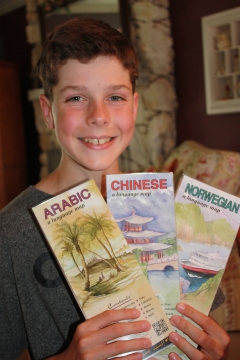
As an example, while I wish to travel to Israel, Hebrew learning becomes more fun. Therefore learning a language and being interested in a foreign land go hand in hand. If you are planning a trip to any country, I TOTALLY would encourage you to learn a language from Bilingual Books. You’ll enjoy yourself! If you are learning a language already, I would support you to dream of taking a vacation to the country where the given language is spoken in, or learn more about the people who speak it. That’s one of the things that make language learning fun.
Another example is that a couple of years ago I REALLY wanted to take a vacation to Amsterdam, an amazing city of canals in the Netherlands. Soon enough, I thought of the cool possibility of learning Dutch.
As for Spanish a few summers past, I once thought of the trip my family and I took to California a few months prior, and all of the Spanish speakers in that state. Then I thought that what I currently was learning might be useful to use the next time we planned to travel to sunny California.
Whether the reader is learning a language or planning a trip, I would recommend you to study with Bilingual Books, the company that makes language learning FUN! Whether you are working with an the army at a base in rugged Afghanistan, cruising around the beautiful Greek islands, visiting exotic Cairo, or trekking through the rain forest in Peru, Bilingual Books will take care of all your language needs!Thanks again for visiting the Bilingual Books blog!
Until next time,
Fraser
Hello, everybody! This is Fraser again, and this week, I would like to tell you about my birthday experience and the great adventures and languages I received on it. Enjoy!
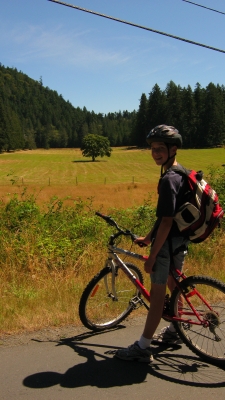
On the day before my birthday, my family and I headed to Mayne Island, one of British Columbia’s beautiful Gulf Islands, for a bike ride. I enjoyed a chilly Root Beer, had the great opportunity to see a seaplane close up, and enjoyed the gentle breeze on the ferry. We had a great time as I anticipated my birthday the next day. For my birthday, I wished for some Bilingual Books!
On Saturday, I turned 13. It was a beautifully sunny morning, and I received from my parents my own ARABIC in 10 minutes a day! Plus, my sister supplied me with the awesome ARABIC a language map, the perfect companion for my book. I’m really glad that I have a Bilingual Books book to learn the language of exotic Egypt, land of the pharaohs, plus sunny Morocco, fascinating Jordan and oil-rich Kuwait. Along with this, I think it’s really cool how that the Arabic-speaking people use so many different sounds than we do in the English language. The illustrations are great, and I think that the Arab world is well portrayed in them.
As for dinner, I asked for an authentic Israeli meal! Consequently, we enjoyed Falafel and Hummus. The next day, I enjoyed another Israeli specialty: Pita with Falafel!
Yes, I had a GREAT time with my family, and received some great products from Bilingual Books.
Have a great week . . . See you next time here at the language club!
Sincerely,
Fraser
Hello, this is Fraser!
Today, I would like to tell you the story of how I started to enjoy learning languages. I hope you enjoy reading it, and that you would see that learning a language can be really fun.
To start, I have always enjoyed cultures and countries. When I was four or five, we had an old computer in our basement. On it, I often would go to study different countries; still today, I enjoy studying atlases, looking at pictures from different countries, and seeing the cultures of different people groups around the world. A couple of years ago, I thought it would be interesting to study a language. Soon, I decided on Spanish, the language of exotic Latin America and sunny Spain. Eventually, we decided on Bilingual Books because it was much less expensive than other language companies. When I got SPANISH in 10 minutes a day, I just LOVED it. However, by the end of the summer, I became busy with school.

Months later, I saw an advert in a home school magazine about Bilingual Books. It had the picture of each different language at Bilingual Books with the word “Hello” on it in the given language. I was surprised at how many languages Bilingual Books were selling! I had only known about the 10 minutes a day languages. More exotic languages such as Swahili and Hawaiian were on sale! I thought that was REALLY cool, and soon purchased my own HAWAIIAN language map. I thoroughly enjoyed that, and became interested in travelling to Hawaii.
Though I never did go to Hawaii, last Christmas day I received from my parents two more 10 minutes a day books; one of the books was to learn Hebrew, while the other was to learn Norwegian. Though I have only written through a couple of pages in Norwegian, I have made lots of progress with Hebrew, and have had lots of time to study it this summer.I still enjoy languages because of my love for countries and cultures of the world, and enjoy seeing progress made in a language. Truthfully, I haven’t ever studied one particular language until I was efficient in it, but simply enjoy “dipping my toes” in many languages. As for now, I’m enjoying Hebrew, and would also like to study Arabic. Currently, I dream of travelling to Israel, the home of the cool Hebrew language.
See you next time at the language club!
All the best,v
Fraserv
 I totally recommend language maps which allow quick reference to any given language in moments. Whether you’re travelling abroad, doing business in a foreign country, or simply wish to learn a language because you are fascinated by the culture of a certain people group, language maps offer a ton of fun. Trust me; I’ve had a LOT of fun with these great products.
Plus, Audio CD’s found in Italian, German, French and Spanish are really cool. Though I’ve only experienced the Spanish Audio CD, I find it quite interesting to hear native speakers and try to imitate the sounds they make. As for the great 10 minutes a day series, I TOTALLY recommend it. I have Spanish in 10 minutes a day, Hebrew in 10 minutes a day and Norwegian in 10 minutes a day. Currently, I am working on Hebrew, a cool language spoken in Israel, where I would like to visit one day. I happily recommend this GREAT book to any vacationer travelling to the beaches in beautiful Eilat, a tourist planning on venturing up to the ancient fortress of Masada, any business-person working in Tel Aviv, or one dreaming of touring the incredible city of Jerusalem.
I’d just like to thank you for checking out Bilingual Books’ new blog . . .
I’m really excited to be writing about the coolest language company this summer!
Until next time,
Fraser
I totally recommend language maps which allow quick reference to any given language in moments. Whether you’re travelling abroad, doing business in a foreign country, or simply wish to learn a language because you are fascinated by the culture of a certain people group, language maps offer a ton of fun. Trust me; I’ve had a LOT of fun with these great products.
Plus, Audio CD’s found in Italian, German, French and Spanish are really cool. Though I’ve only experienced the Spanish Audio CD, I find it quite interesting to hear native speakers and try to imitate the sounds they make. As for the great 10 minutes a day series, I TOTALLY recommend it. I have Spanish in 10 minutes a day, Hebrew in 10 minutes a day and Norwegian in 10 minutes a day. Currently, I am working on Hebrew, a cool language spoken in Israel, where I would like to visit one day. I happily recommend this GREAT book to any vacationer travelling to the beaches in beautiful Eilat, a tourist planning on venturing up to the ancient fortress of Masada, any business-person working in Tel Aviv, or one dreaming of touring the incredible city of Jerusalem.
I’d just like to thank you for checking out Bilingual Books’ new blog . . .
I’m really excited to be writing about the coolest language company this summer!
Until next time,
Fraser





